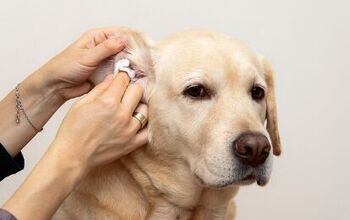Should I Feed My Dog In a Raised Dish?

The use of an elevated feeder may appear, at the surface, to be a matter of design and aesthetics. But your choice of feeding bowl can significantly impact your dog’s health and well-being more than you might think. The height of your dog’s feeding bowls can influence their comfort and digestion, among other things. Elevated feeding bowls, in particular, have gained popularity among pet owners in recent years.
But is an elevated feeder the right choice for your dog? Should you be making a change to your dog’s mealtime routine and setup?
In this guide, I’ll share the potential benefits of elevated feeding bowls and what you should consider when deciding whether a raised feeder is suitable for your dog. I will explain how these bowls can improve your dog’s posture, aid digestion, and reduce joint strain. Plus, I’ll address the potential drawbacks of using a raised dish to help you make an informed decision for your canine companion.
Are Raised Dishes Good for Dogs?
This has long been a debate in the pet world. Why is the discussion of raised feeders so polarizing? The research simply isn’t there to give a concrete answer as to whether they benefit our dogs or put them at risk. Furthermore, with the information that is available, experts say the answer will vary from dog to dog. Some pups will benefit greatly from using these feeders, while others may be at higher risk for trouble.
Deciding whether or not to use a raised dish starts with learning the pros and cons of these products. I also recommend discussing your dog’s unique needs and risk factors with your veterinarian. This will allow you to make an educated decision.
With that in mind, let’s break down the benefits and possible disadvantages…
Benefits of Raised Feeders for Dogs
Why should you consider using a raised dish? In some situations, elevating your dog’s dish could make mealtime more accessible, more comfortable, and even cleaner… Here are a few of the most common benefits and reasons people reference for choosing to switch to a raised dish:
Reduced Strain When Eating
Arguably, the most important reason to consider using a raised feeder (and the reason that leads veterinarians to recommend their use) is how they limit the strain associated with bending down to reach a dish sitting on the ground. Stretching their neck down to a traditional dog bowl may not seem like a big deal for many dogs, especially smaller or toy breeds who are already close to the ground. However, for others, it can put a lot of strain on the body trying to reach down.
This benefit is most associated with dogs who are living with:
- Age-related limited mobility
- Arthritis
- Spinal conditions
- Orthopedic conditions or injuries
- Joint disorders or injuries
Keep the Mess Contained
Do you have a dog that makes a big mess when eating or drinking? We have all met at least one dog that leaves behind a puddle after quenching their thirst. Many raised feeders are designed to incorporate features that keep the mess contained. This includes preventing spills and trapping any food/water to keep it from landing on your floor.
Stop Chasing the Dish
Whether your dog struggles with eating while their dish slides across the floor or has a habit of pawing at their dish, knocking it around the room, a raised feeder can help to prevent the dish from moving. This movement can complicate mealtime either by creating frustration as they try to eat or by creating a mess (going back to the previous point).
There are no-slip bowl designs that can help to address this problem. However, a raised feeder that securely holds the dish in place up and away from your dog’s paws and any slippery floors will eliminate the problem entirely in most cases.
Possible Drawbacks of Using Raised Dishes
Once believed to prevent bloat by adjusting the position a dog is eating at, further study revealed the opposite may be true.
Bloat, or gastric dilation-volvulus (GDV), is a potentially life-threatening situation where the stomach fills with food, fluid, or gas and flips or twists. This rotation cuts off the entrance and exit of the stomach, preventing the contained substances from continuing to travel through the digestive system and cutting off blood flow to the rest of the body (including vital organs). It is a life-threatening emergency.
So, the big question is – Do raised dog dishes cause bloat? The answer is maybe.
A study out of Purdue University suggested that large and giant dog breeds may increase their risk of bloat when eating from a raised feeding bowl. Of the dogs in the study, approximately 52% of GDV cases were attributed to the feeder. However, many experts question elements of the study, saying it wasn’t an accurate representation as it failed to account for other potential facts. For example, the pet parents feeding with a raised dish in the study were those who chose to do so rather than assigning their use and establishing a control group. This means there could be other related lifestyle factors to consider.
Further research is needed to finally answer this question once and for all.
How to Choose the Best Raised Feeder for Your Pup
If, after reading through the pros and cons, you believe a raised feeder may be the right choice for your dog, it’s time to start shopping. There are many different styles, sizes, and features to consider. Here are a few factors to consider that will help you narrow down your list of options:
Size/Height
The first and arguably most important factor to consider is the height of the raised feeder relative to your dog. When a raised feeder is sized appropriately, your dog can stand in front of it and eat without stretching their neck or contorting their body.
If a feeder is too low, your dog will still have to reach down to the dish, contradicting the purpose of elevating it. On the other end of the spectrum, a feeder that is too tall will require your dog to strain their neck, reaching up to get to their meal. The added strain and effort required can cause unnecessary pain and discomfort in both situations.
Material
Raised feeders are available in a wide range of materials, including plastic, wood, ceramic, and stainless steel. There is no one “best” material. Instead, you will need to consider the durability, ease of cleaning, appearance, and personal preferences – including both your preference and your dog’s.
This may involve balancing these considerations. For example, a stainless steel feeder is easier to clean and disinfect, but some dogs are bothered by the reflection of stainless steel and will refuse to eat out of it. Others may be okay with the stainless steel dish as long as the feeder is another non-reflective material.
Stability
Consider how frustrating eating from a dish could be if the dish is constantly moving or swaying as you’re trying to eat. You likely wouldn’t enjoy that, and neither will your dog. The ideal feeder will hold the dish in a secure and stable way, even if your dog is bumping against it while eating.
If you are shopping from your local pet store, consider testing the stability by pushing on the feeder at different angles. If you are shopping online, you can still test the models in-store to understand how different styles of feeders will perform.
Ease of Cleaning
The U.S. Food and Drug Administration (FDA) recommends pet parents clean their pet food dishes after every meal. Yet, experts warn, most don’t follow this advice. As a result, your dog may be exposed to bacteria and other contaminants. To make it easier to properly clean and disinfect your dog’s dishes, choose a design limiting the nooks and crannies where bacteria can be trapped or challenging to clean. The best designs can be easily disassembled.
Added Features
Some raised feeders offer unique features or elements that may better address your dog’s needs. For example, if your dog tends to eat their food too quickly, you will want to choose a feeder that either incorporates a slow feeder or uses standard dog dish sizes so you can convert it to a slow feeder yourself. Other features you may be interested in include mess shields around the back, adjustable height/width sizing, incorporated lick mats, and more.
Aesthetics
Of course, being a pet parent doesn’t mean we have to sacrifice our dream home aesthetic. With so many raised feeders on the market, there are options to fit every style – modern, rustic, industrial, art deco, bohemian… you name it! After settling on the functional factors mentioned above, look at the remaining feeders on your list and consider how they will fit with your home décor.
Our Go-To Raised Feeder: Neater Feeder Deluxe
While we don’t currently use a raised feeder in our house with our two pups, our former pups did use one throughout their senior years. Both Daviana and Indiana were larger dogs (a German Shepherd mix and a Flat-Coated Retriever mix), and bending down to reach their food dish became uncomfortable and challenging when they started to experience age-related aches and pains. That was when we knew that we needed to make a change.
We tried several different feeds to find the right fit for our house. However, we were quickly sold after introducing the Neater Feeder Deluxe Model!
Indiana was always a messy eater. We used to joke that he was washing our floors when he drank. This particular feeder had several features that helped to contain the mess. The raised splash-proof barrier behind the dishes protects your walls and furniture. Meanwhile, the feeder includes a drain and catch basin to separate spilled food and water, making cleaning easy.
The Neater Feeder is available in 3 different sizes (small, medium, and large), plus there are optional leg extensions to customize the height further. They hold standard stainless steel dishes, but the company also offers a slow feeder model.
Final Thoughts: Raised Feeders for Dogs
Raised feeders can be a great option for dogs with mobility issues, joint pain, or those who tend to make a significant mess during mealtime. However, the jury is still out on whether using a raised dish increases the risk of bloat in large or giant breed dogs, like Saint Bernards, Bernese Mountain Dogs, and Great Danes.
There is no one-size-fits-all answer to the question of whether or not a raised feeder is right for your dog.
Instead, it’s your job as a responsible pet parent to weigh the pros and cons, considering your dog’s individual needs and risk factors. If you decide to use a raised feeder, make sure to choose one that is the right size and height for your dog. Consider functional aspects like stability, durability, and ease of cleaning to find the best fit for your dog and your home.
Remember, If you are unsure whether to switch to a raised feeder, your veterinarian is always your best resource for personalized advice on your dog’s health and well-being.
Join the PetGuide community. Get the latest pet news and product recommendations by subscribing to our newsletter here.

Britt Kascjak is a proud pet mom, sharing her heart (and her home) with her “pack” which includes her husband John, their 2 dogs – Lucifer and Willow – and their 2 cats – Pippen and Jinx. She has been active in the animal rescue community for over 15 years, volunteering, fostering and advocating for organizations across Canada and the US. In her free time, she enjoys traveling around the country camping, hiking, and canoeing with her pets.
More by Britt
























